LYRIC DOES THE BESS THAT IT CAN
After two outings to Spain (Don Giovanni and Il Trovatore) and one to Paris (Capriccio), Lyric Opera is bringing audiences something homegrown, composed by an American and set in South Carolina. Porgy and Bess should be rather familiar to Lyric audiences, since it played here just six years ago in 2008.
While there are plenty of new faces, most notably soprano Adina Aaron as Bess, much of the current production, from Peter J. Davison’s set to Paul Tazewell’s costumes, has carried over from the previous one. Also returning are director Francesca Zambello, lighting designer Mark McCullough, choreographer Denni Sayers, and fight director Chuck Coyl. Even some of the singers have reprised their roles, such as Veronica Chapman-Smith as Lily, while others have returned in different roles. Relative newcomer Ward Stare conducts the orchestra with flare and finesse.
Originally written by Dubose Heyward as a novel in 1925, Porgy and Bess was then co-adapted with his wife Dorothy Heyward into a play in 1927. But ever since its operatic debut in 1935, Porgy and Bess has been associated with the music of Gershwin. That music has taken on a life of its own, as numerous recordings and productions can attest. Gershwin himself described Porgy and Bess as a folk opera, since it draws on many American musical styles, such as jazz, blues, and spirituals. The result is a rich, harmonious, and tuneful score with a broad appeal beyond that of the dominant Italian operatic tradition.
Porgy and Bess tells the story of how two marginalized figures find love and acceptance in a poor black community. Porgy (Eric Owens) is a crippled beggar and Bess is Crown’s girl. When the thuggish Crown (Eric Greene) kills Robbins (Bernard Holcomb) and flees town, Bess is turned away by everyone but Porgy. Although they make an unlikely couple, under Porgy’s constant care and protection, Bess becomes a respectable woman.
Continuing tension is provided by Crown’s various attempts to reclaim Bess, which ends with Crown and Porgy fighting to the death. In the end, it is the drug-dealer Sportin’ Life who takes Bess away to New York. Despite the deaths of four characters and the separation of the titular lovers, the story ends on a hopeful note with Porgy setting off to find Bess.
Thanks to Gershwin’s music and his brother Ira’s lyrics (co-written with Heyward), the plot of Porgy and Bess is continually punctuated by memorable and beloved songs. Making her Lyric debut as Clara, Ryan Opera Center member Hlengiwe Mkhwanazi sings “Summertime” with ease and grace, her velvety voice setting a high standard from the outset. Baritone Norman Garrett, also making his Lyric debut as her husband Jake, jestingly follows it with “A Woman Is a Sometime Thing.”
Owens’ Porgy soon arrives on the scene, but we don’t really get a good sense of what his voice is capable of until he entertains us with “I Got Plenty o’ Nuttin’.” In that song, Owens reveals his vocal dexterity and tremendous power. But there is also plenty of emotional depth and sensitivity in his barrel-chested bass-baritone, which he displays poignantly in his duet with Aaron, “Bess, You Is My Woman Now.”
Returning from Lyric’s previous incarnation as Sportin’ Life, Jermaine Smith sings “It Ain’t Necessarily So” with all the minstrelsy and vocal acrobatics of Cab Calloway. Its humor is underscored by Smith’s wildly exaggerated gestures and flashy dance moves. Gwendolyn Brown as Maria also provides plenty of laughs, but her commanding contralto comes off a bit rough, even for such a folksy opera as this.
The cast’s talented principals are supported by an excellent chorus under the direction of Michael Black. They add plenty of life and shading to the production, especially during the haunting spiritual “Gone, Gone, Gone.”
Fortunately, Porgy and Bess shows no signs of disappearing into oblivion but all the signs of being fully accepted into the canon, despite recurring criticisms of the opera as racist. Wisely and stubbornly, the Gershwins have always insisted that the cast be exclusively black, with the exception of the white speaking roles. It really wouldn’t work any other way.
Exceeding three hours in length, Porgy and Bess rivals even Verdi’s Il Trovatore in sheer scale. There is simply a lot going on in this rather ill-fated love story. While the current production is somewhat tired and lacking originality, Lyric Opera manages to marshal an impressive roster of new and old talent, breathing life once more into a beloved American classic.
photos by Todd Rosenberg
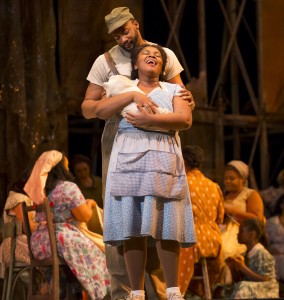 Porgy and Bess
Porgy and Bess
Lyric Opera of Chicago
Civic Opera House
20 N. Wacker Drive
ends on December 20, 2014
for tickets, call 312.827.5600
or visit Lyric Opera
for more shows,
visit Theatre in Chicago
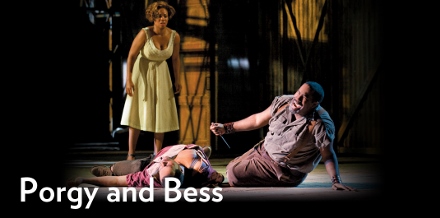
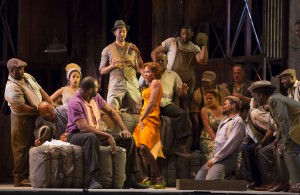
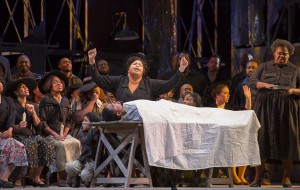
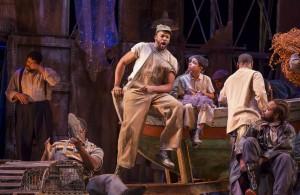
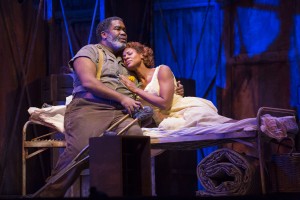
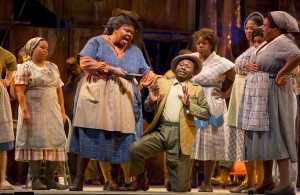
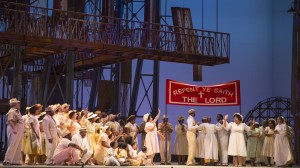
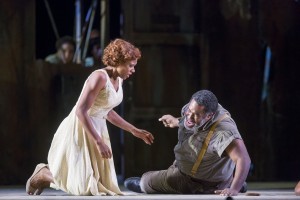
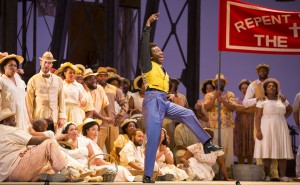
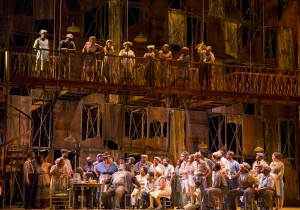
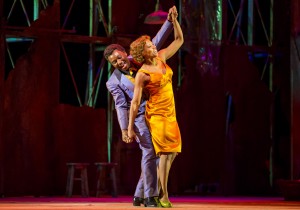
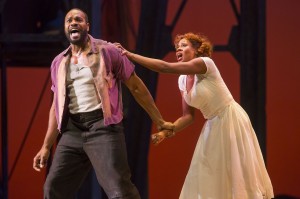

{ 1 comment… read it below or add one }
Sorry but I do not agree with the general review of Porgy and Bess. I just returned from the performance and was bored. There was a lot wrong with the voices and the chorus. It just did not sound right.
Question – does Porgy and Bess really belong at Lyric Opera? A great opera is one you can’t wait to hear again and again. For sure I have no interest to hear this again for many years. My tickets cost $229. Only buy at a big discount if you want to go this season. There are plenty of tickets for sale.